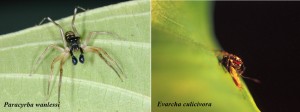Spider preys almost exclusively on mosquitoes

Paracyrba wanlessi, the Malaysian jumping spider, eats swarms of mosquitoes, the disease-transmitting insects responsible for millions of deaths a year due to malaria and other illnesses.
“Many other animals, including other spiders, may sometimes eat mosquitoes,” says study co-author Fiona Cross, a biologist at the U.K.’s University of Canterbury ,“but this spider is different, because this is a species that loves mosquitoes more than anything else!”
In fact, when Cross and colleagues reared spiders in the lab on non-mosquito diets and then gave the arachnids various options on the menu, they still chose mosquitoes. “This active preference for mosquitoes is highly unusual,” she said.
So far only one other animal is known to be such a strong mosquito specialist: another jumping spider from tropical Africa called Evarcha culicivora. This arachnid also happens to prefer Anopheles mosquitoes—the worst offenders in spreading disease, particularly malaria.
This is an example of convergent evolution; the two distantly related spiders evolved very similar traits—in this case, eating mosquitoes—independently, according to the study. But at mealtime, the two spiders enlist quite opposite strategies.
Most remarkably, Paracyrba will eat mosquitoes of various species at all stages of life—even though juvenile and adult mosquitoes are distinctly different animals, looking almost nothing alike. This kind of double-barrel specialization on mosquitoes has never been demonstrated for a predator before, says study leader Robert Jackson.
“Paracyrba [like other jumping spiders] has extraordinarily good eyesight and hunts for its prey like a miniature cat,” Cross said.
Such an innate, rather extreme behavior certainly has researchers swatting around big-picture possibilities.
“Any predator that singles out mosquitoes as preferred prey has to be of exceptional interest,” says Jackson. “These insects are notorious vectors of malaria, dengue, and other diseases,” especially in the tropical environments where the jumping spiders live.
Of course, no one would advocate simply turning spiders loose in places where mosquitoes and the infections they spread are problematic, especially if the spiders aren’t normally there.
And no spider, no matter how hungry, will be a magic bullet that will rid us of mosquito-borne disease. But further study and creative thinking might suggest a role for them in solving a major public health problem. “And they are out there in nature for free,” Jackson says.
“Paracyrba is believed common in its Asian bamboo-forest habitat, but habitat destruction is happening now on such a massive scale, sometimes it’s hard to be optimistic.”

